Walter Sickert, Tate Britain review - all the world's a stage | reviews, news & interviews
Walter Sickert, Tate Britain review - all the world's a stage
Walter Sickert, Tate Britain review - all the world's a stage
The artist as voyeur
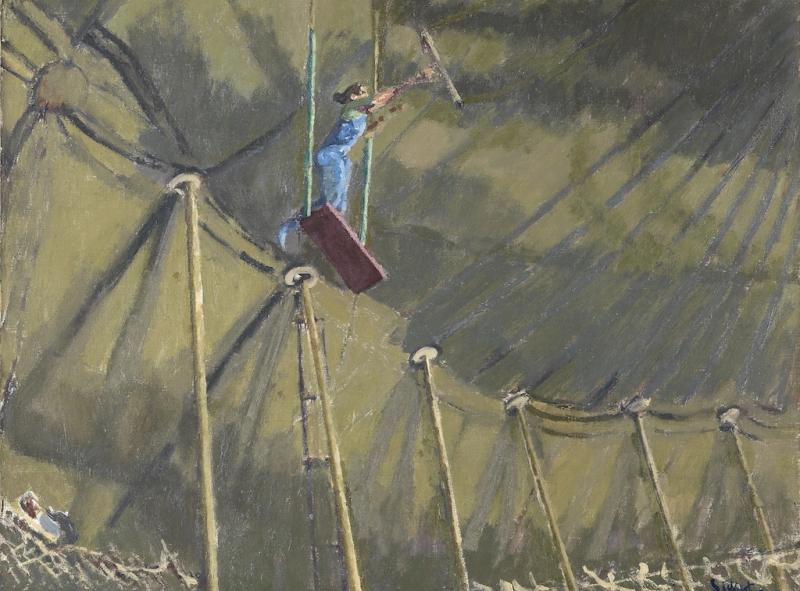
Who was Walter Sickert and what made him tick? The best way to address the question is to make a beeline for the final room of his Tate Britain retrospective. It’s hung with an impressive array of his last and most colourful paintings.
By contrast, the early rooms are hung with paintings so dark that your eyes can’t adjust to them, especially if you’ve come in from bright sunshine; trying to decipher their almost black surfaces feels like peering into the void.
Before reaching that last room, I’d spent the entire exhibition trying to fathom this artist who seems as slippery as an eel. Light – its presence or absence – was clearly an ongoing preoccupation. For instance, in his 1923 portrait of the artist Cicely Hey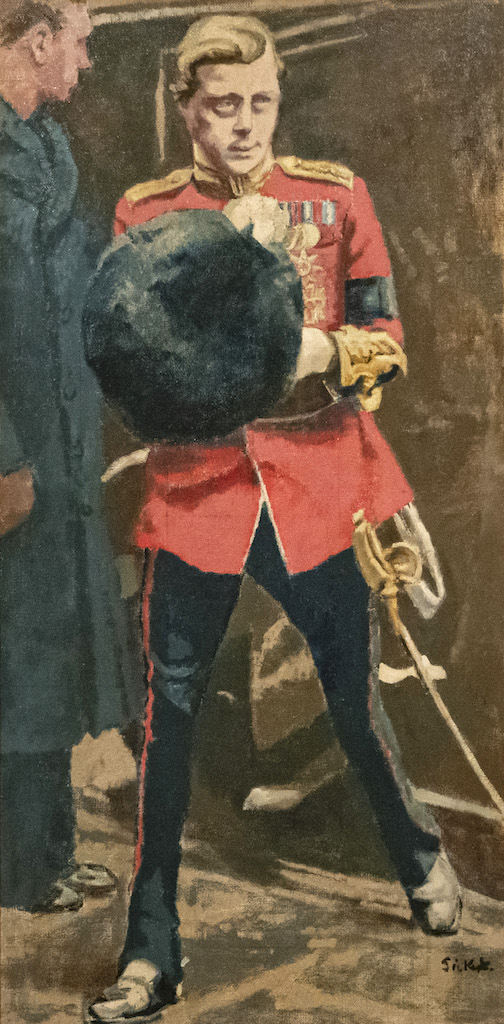 who was a close friend, he focuses on the firelight shining on her face and turning her features into a ghoulish mask. The sitter is merely one of his “studies of illumination".
who was a close friend, he focuses on the firelight shining on her face and turning her features into a ghoulish mask. The sitter is merely one of his “studies of illumination".
Much is made of the fact that Sickert started out as an actor and remained enamoured of the stage. He went to cafés, music halls or theatres nearly every night, but his many paintings of performers – whether music hall singers, trapeze artists, Shakespearean actors or seaside clowns – lack the buzz of excitement captured by Degas, Manet and Toulouse Lautrec in their paintings of Parisian night life. Again, Sickert seems more interested in light – the glare of footlights on the performers, glinting off ornate gilding or illuminating the riff-raff in the balcony (pictured below left: Gallery of the Old Bedford 1894-5) – than in the atmosphere of the place.
His friend and mentor Edgar Degas was a key influence in his choice of subject matter and also in his habit of working from sketches or, later on, from photographs. The odd perspective of The Trapeze, 1920 (main picture) pays homage to Degas’ Mlle Lala at the Cirque Fernando, 1879. In Degas’ painting, you can almost hear audience members catch their breath as they watch the twirling Lala hang by her teeth, but Sickert’s trapeze artist is dwarfed by the dome of the big top. Seemingly lost and lonely, she might as well be performing to an empty house.
Nuit d’Amour, 1922 shows the green exterior of Vernet’s, a cafe which the artist visited every night when he lived in Dieppe. The warm glow of the chandeliers and the glimpse of a violinist entertaining the punters makes the interior extremely inviting but, as in an Edward Hopper painting, we are outside looking in. Easter, 1928 (pictured below) features another exterior, of a shopfront. The windows of Dawson Brothers, a draper’s on City Road near Old Street, are filled with Easter bonnets suggestive of happy gatherings and Easter Parades. But it’s late, the shop is closed and the loan figure on the pavement outside peers longingly in the window.
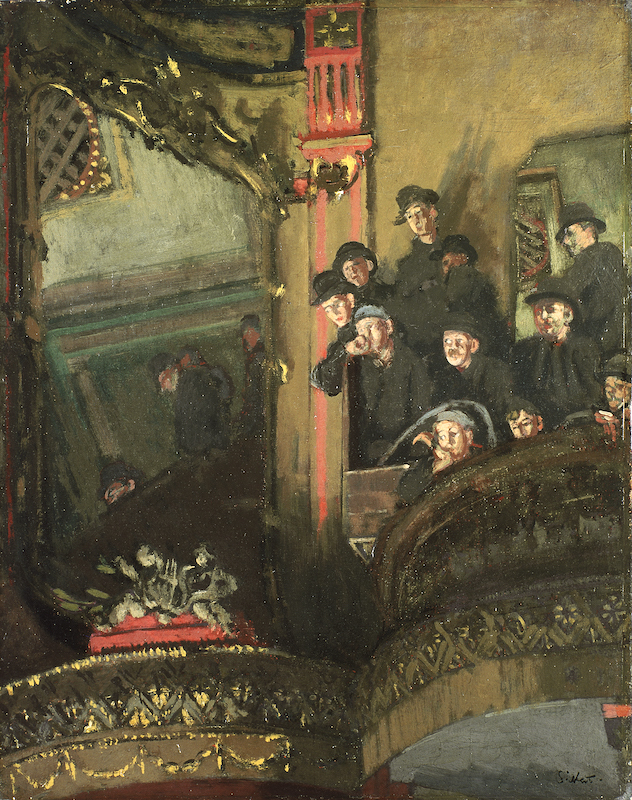 An image is forming in my mind of Sickert as an observer – a voyeur who prefers to watch rather than engage and who often feels like an outsider. The idea is confirmed by the glorious paintings in the final room in which he grabs an image from a newspaper, blows it up, transfers it onto canvas with the help of a camera lucida and thus transforms a split second of time into a snapshot of an era. Edward VIII (pictured above right) is shown nervously stepping into the public eye, hopelessly unprepared for royal office (he would abdicate a few months later). Jack and Jill, 1938 features Edward G. Robinson and Joan Blondell, stars of the gangster movie Bullets and Ballots. Sickert has drained all the warmth from the original publicity shot to make the pair look as terrified as rabbits caught in the headlights – trapped in the glare of publicity. Seeing and being seen – whether on the world stage, in the theatre, or on screen – is the main subject of paintings which anticipate Warhol’s explorations of celebrity by nearly 30 years.
An image is forming in my mind of Sickert as an observer – a voyeur who prefers to watch rather than engage and who often feels like an outsider. The idea is confirmed by the glorious paintings in the final room in which he grabs an image from a newspaper, blows it up, transfers it onto canvas with the help of a camera lucida and thus transforms a split second of time into a snapshot of an era. Edward VIII (pictured above right) is shown nervously stepping into the public eye, hopelessly unprepared for royal office (he would abdicate a few months later). Jack and Jill, 1938 features Edward G. Robinson and Joan Blondell, stars of the gangster movie Bullets and Ballots. Sickert has drained all the warmth from the original publicity shot to make the pair look as terrified as rabbits caught in the headlights – trapped in the glare of publicity. Seeing and being seen – whether on the world stage, in the theatre, or on screen – is the main subject of paintings which anticipate Warhol’s explorations of celebrity by nearly 30 years.
Retracing my steps I become aware, though, that things are more complicated. With eyes now attuned to the light, I can see the earlier pictures more clearly. Painted in the sombre browns and ochres that Sickert preferred for most of his career, Ennui, 1913 shows a couple stuck in a relationship of mutual indifference. The man gazes into the distance, smoking, while leaning on a chest of drawers, the woman stares at the walls of the dreary room as though in surrender to abject despair. The atmosphere is as lifeless as the dead birds trapped under a bell jar beside her elbow.
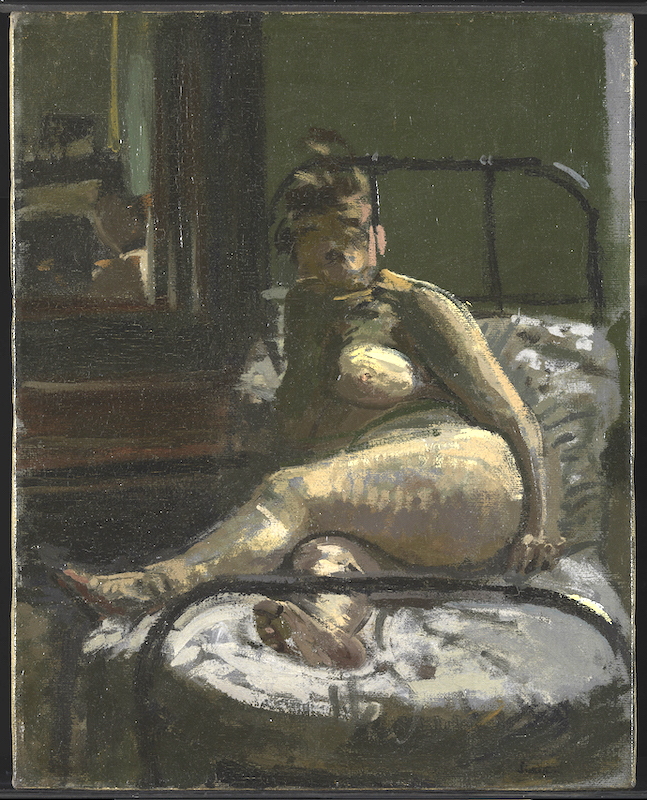 A similar mood of dejection permeates the Camden Town Murder series, which feature a naked woman lying on an iron bedstead in a dingy room (pictured right: La Hollandaise c.1906). In What Shall We Do For the Rent? 1908 a man sits beside her, head bowed as though agonising over the question. The implied answer to the problem is prostitution, but the title of the series refers to the recent murder of prostitute Emily Dimmock, which amply demonstrated the risks involved in such a choice. In L’Affaire de Camden Town 1909, a client looms over a naked woman as if contemplating what to do next, while an associated drawing shows him strangling her.
A similar mood of dejection permeates the Camden Town Murder series, which feature a naked woman lying on an iron bedstead in a dingy room (pictured right: La Hollandaise c.1906). In What Shall We Do For the Rent? 1908 a man sits beside her, head bowed as though agonising over the question. The implied answer to the problem is prostitution, but the title of the series refers to the recent murder of prostitute Emily Dimmock, which amply demonstrated the risks involved in such a choice. In L’Affaire de Camden Town 1909, a client looms over a naked woman as if contemplating what to do next, while an associated drawing shows him strangling her.
Sickert’s attitude to these sorry scenes remains ambiguous. While apparently sympathising with the plight of the women, he makes them as unappealing as possible. Their heavy bodies and ungainly poses (they often lie with legs splayed) and the addition of details such as a chamber pot under the bed emphasise the sordid reality of the encounters he portrays. Far from being seductive, his nudes represent sex as a squalid transaction without a scintilla of romance.
But there’s an even more sinister dimension to the series. Sickert’s fascination with Jack the Ripper and the murders he committed in Whitechapel in 1888 is well known, but recent research reveals that he actually wrote to the police claiming to be the killer and even decorated his letters with sketches of men brandishing knives over naked women.
Yet this would-be murderer would later liken himself to an Old Testament patriarch. In The Servant of Abraham, 1921, he stares at us as though in judgement. Sketchily painted in browns and ochres, his head appears to belong to a figure of enormous stature, both physically and metaphorically – a veritable giant among men.
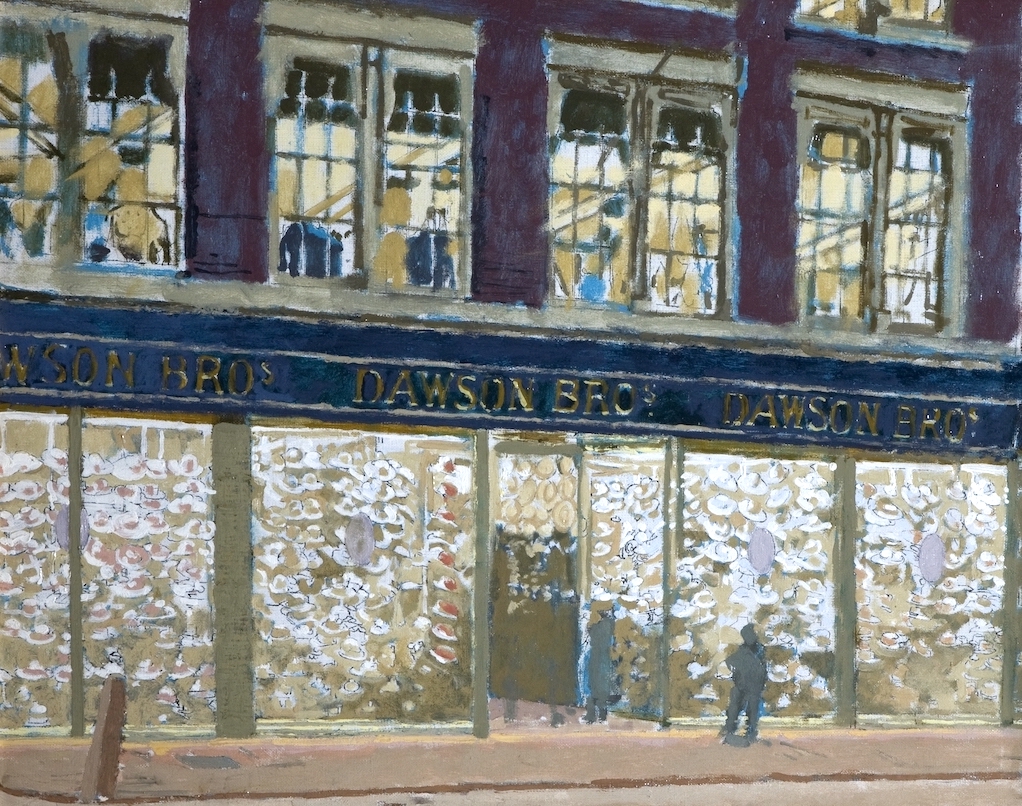 For Sickert it seems that painting was mainly a form of story telling – a platform for the performance of various scenarios – or an opportunity to witness real performers and their audiences. Having given up acting, he became the archetypal voyeur, fascinated by watching and being watched and also by light, the element that makes looking possible.
For Sickert it seems that painting was mainly a form of story telling – a platform for the performance of various scenarios – or an opportunity to witness real performers and their audiences. Having given up acting, he became the archetypal voyeur, fascinated by watching and being watched and also by light, the element that makes looking possible.
rating
Explore topics
Share this article
The future of Arts Journalism
You can stop theartsdesk.com closing!
We urgently need financing to survive. Our fundraising drive has thus far raised £49,000 but we need to reach £100,000 or we will be forced to close. Please contribute here: https://gofund.me/c3f6033d
And if you can forward this information to anyone who might assist, we’d be grateful.

Subscribe to theartsdesk.com
Thank you for continuing to read our work on theartsdesk.com. For unlimited access to every article in its entirety, including our archive of more than 15,000 pieces, we're asking for £5 per month or £40 per year. We feel it's a very good deal, and hope you do too.
To take a subscription now simply click here.
And if you're looking for that extra gift for a friend or family member, why not treat them to a theartsdesk.com gift subscription?
more Visual arts
 'We are bowled over!' Thank you for your messages of love and support
Much-appreciated words of commendation from readers and the cultural community
'We are bowled over!' Thank you for your messages of love and support
Much-appreciated words of commendation from readers and the cultural community
 Photo Oxford 2025 review - photography all over the town
At last, a UK festival that takes photography seriously
Photo Oxford 2025 review - photography all over the town
At last, a UK festival that takes photography seriously
![SEX MONEY RACE RELIGION [2016] by Gilbert and George. Installation shot of Gilbert & George 21ST CENTURY PICTURES Hayward Gallery](https://theartsdesk.com/sites/default/files/styles/thumbnail/public/mastimages/Gilbert%20%26%20George_%2021ST%20CENTURY%20PICTURES.%20SEX%20MONEY%20RACE%20RELIGION%20%5B2016%5D.%20Photo_%20Mark%20Blower.%20Courtesy%20of%20the%20Gilbert%20%26%20George%20and%20the%20Hayward%20Gallery._0.jpg?itok=7tVsLyR-) Gilbert & George, 21st Century Pictures, Hayward Gallery review - brash, bright and not so beautiful
The couple's coloured photomontages shout louder than ever, causing sensory overload
Gilbert & George, 21st Century Pictures, Hayward Gallery review - brash, bright and not so beautiful
The couple's coloured photomontages shout louder than ever, causing sensory overload
 Lee Miller, Tate Britain review - an extraordinary career that remains an enigma
Fashion photographer, artist or war reporter; will the real Lee Miller please step forward?
Lee Miller, Tate Britain review - an extraordinary career that remains an enigma
Fashion photographer, artist or war reporter; will the real Lee Miller please step forward?
 Kerry James Marshall: The Histories, Royal Academy review - a triumphant celebration of blackness
Room after room of glorious paintings
Kerry James Marshall: The Histories, Royal Academy review - a triumphant celebration of blackness
Room after room of glorious paintings
 Folkestone Triennial 2025 - landscape, seascape, art lovers' escape
Locally rooted festival brings home many but not all global concerns
Folkestone Triennial 2025 - landscape, seascape, art lovers' escape
Locally rooted festival brings home many but not all global concerns
 Sir Brian Clarke (1953-2025) - a personal tribute
Remembering an artist with a gift for the transcendent
Sir Brian Clarke (1953-2025) - a personal tribute
Remembering an artist with a gift for the transcendent
 Emily Kam Kngwarray, Tate Modern review - glimpses of another world
Pictures that are an affirmation of belonging
Emily Kam Kngwarray, Tate Modern review - glimpses of another world
Pictures that are an affirmation of belonging
 Kiefer / Van Gogh, Royal Academy review - a pairing of opposites
Small scale intensity meets large scale melodrama
Kiefer / Van Gogh, Royal Academy review - a pairing of opposites
Small scale intensity meets large scale melodrama
 Jenny Saville: The Anatomy of Painting, National Portrait Gallery review - a protégé losing her way
A brilliant painter in search of a worthwhile subject
Jenny Saville: The Anatomy of Painting, National Portrait Gallery review - a protégé losing her way
A brilliant painter in search of a worthwhile subject
 Abstract Erotic, Courtauld Gallery review - sculpture that is sensuous, funny and subversive
Testing the boundaries of good taste, and winning
Abstract Erotic, Courtauld Gallery review - sculpture that is sensuous, funny and subversive
Testing the boundaries of good taste, and winning
 Edward Burra, Tate Britain review - watercolour made mainstream
Social satire with a nasty bite
Edward Burra, Tate Britain review - watercolour made mainstream
Social satire with a nasty bite

Add comment